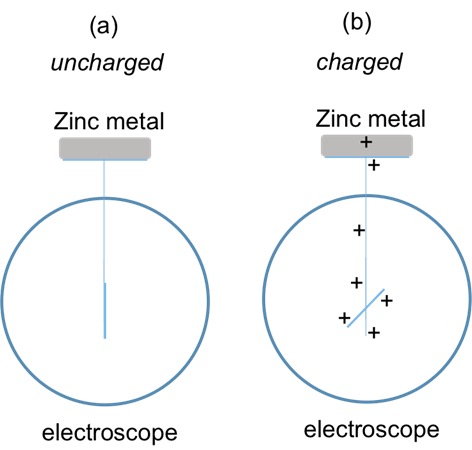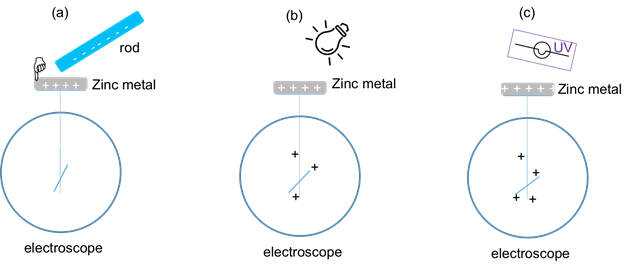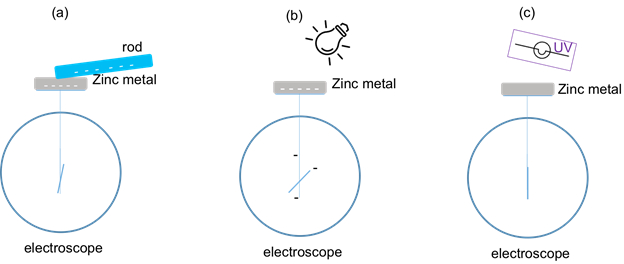Photoelectric Effect
Overview
Source: Yong P. Chen, PhD, Department of Physics && Astronomy, College of Science, Purdue University, West Lafayette, IN
Photoelectric effect refers to the emission of electrons from a metalwhen light is shining on it. In order for the electrons to be liberated from the metal, the frequency of the light needs to be sufficiently high such that the photons in the light have sufficient energy. This energy is proportional to the light frequency.The photoelectric effect provided the experimental evidence for the quantum of light that is known as photon.
This experiment will demonstrate the photoelectric effect using a charged zinc metal subject to either a regular lamp light, or ultraviolet (UV) light with higher frequency and photon energy.The zinc plate will be connected to an electroscope, an instrument that can read the presence and relative amount of charges. The experiment will demonstrate that the UV light, but not the regular lamp, can discharge the negatively charged zinc by ejecting its excess electrons.Neither light source, however, can discharge positively charged zinc, consistent with the fact that electrons that are emitted in photoelectric effect.
Procedure
1. Obtain the Needed Components for This Experiment
- Obtain an electroscope (Figure 1), which is a device that monitors the charge on the metal plate connected to the electroscope.Due to the coulomb repulsion force between the charges, the needle inside the electroscope will deflect more (or less) if there are more (or less) charges on the plate, and will not move if there are no charges.
- Obtaina zinc metal plate.Use sandpaper to polish its surface (this removes the zinc oxide on the
Results
For steps 2.1-2.4, the electroscope remains charged (needle remain deflected) for both the regular lamp and UV light illumination (Figure 2b and 2c), indicating that the zinc plate remains positively charged.This is because the charged zinc plate (which has already lost some electrons in the first place to become positively charged) further losessome photoelectrons by the UV light to make it further positively charged. In thiscase, itmay be noticeablethat the needle of the e
Application and Summary
In this experiment, we haveused an electroscope to show that UV light can discharge a negatively charged zinc metal through the photoelectric effect.In contrast, a positively charged zinc sample (which has already lost some electrons) will not be discharged, nor will a visible light (which cannot cause the photoelectric effect) discharge either negatively or positively charged zinc.
The photoelectric effect played important roles in the development of quantum physics in the 20th cen
Skip to...
Videos from this collection:

Now Playing
Photoelectric Effect
Physics II
32.8K Views

Electric Fields
Physics II
77.8K Views

Electric Potential
Physics II
105.5K Views

Magnetic Fields
Physics II
33.8K Views

Electric Charge in a Magnetic Field
Physics II
33.8K Views

Investigation Ohm's Law for Ohmic and Nonohmic Conductors
Physics II
26.3K Views

Series and Parallel Resistors
Physics II
33.2K Views

Capacitance
Physics II
43.9K Views

Inductance
Physics II
21.7K Views

RC/RL/LC Circuits
Physics II
143.2K Views

Semiconductors
Physics II
30.3K Views

Reflection and Refraction
Physics II
36.4K Views

Interference and Diffraction
Physics II
91.6K Views

Standing Waves
Physics II
50.0K Views

Sound Waves and Doppler Shift
Physics II
23.6K Views
Copyright © 2025 MyJoVE Corporation. All rights reserved


